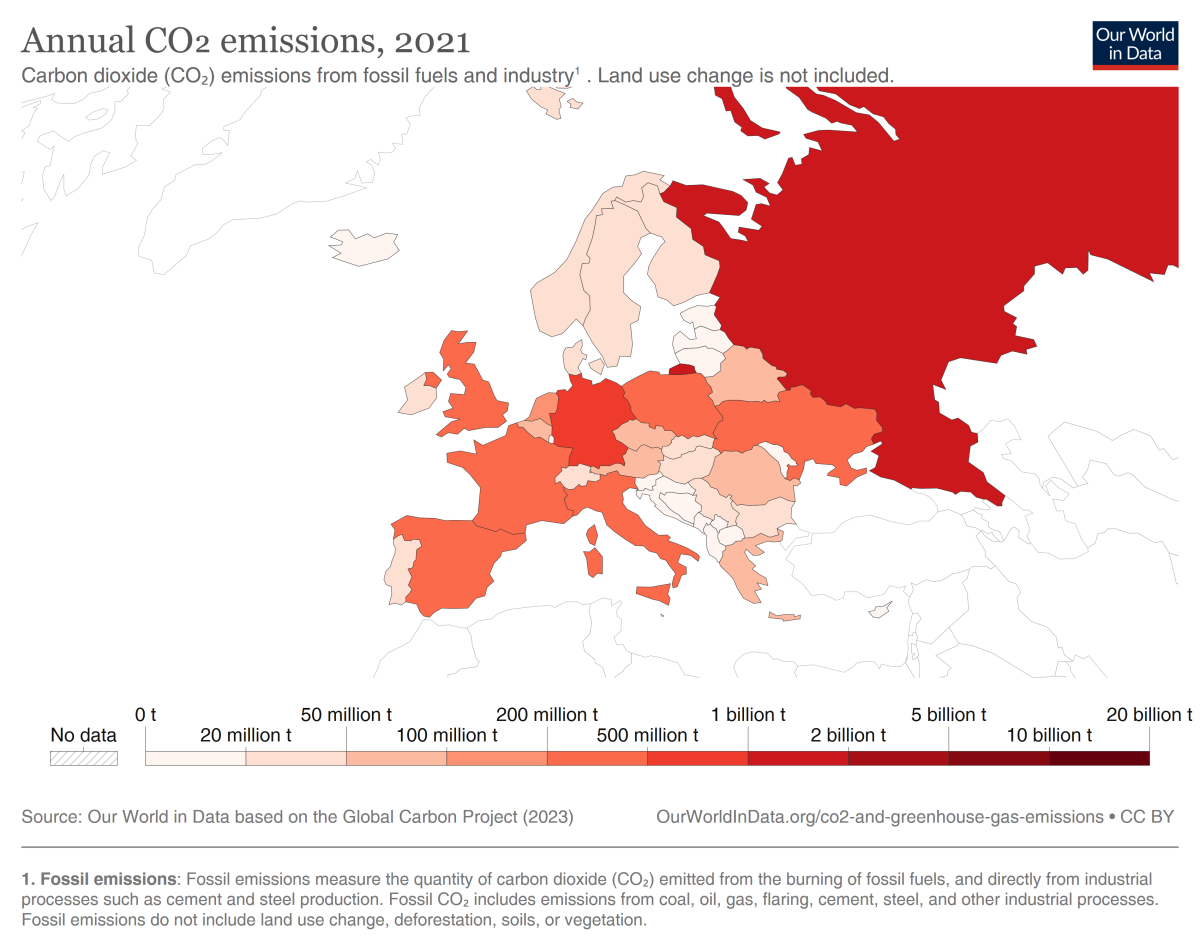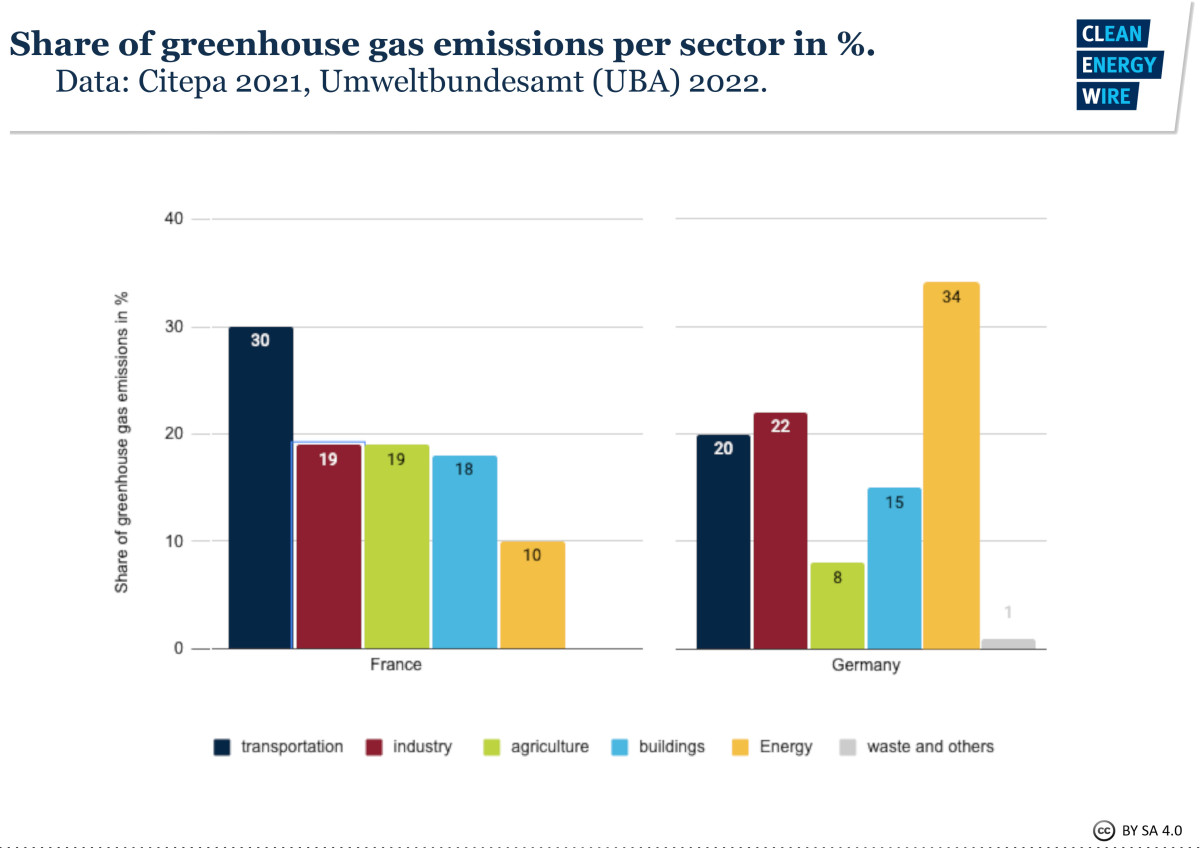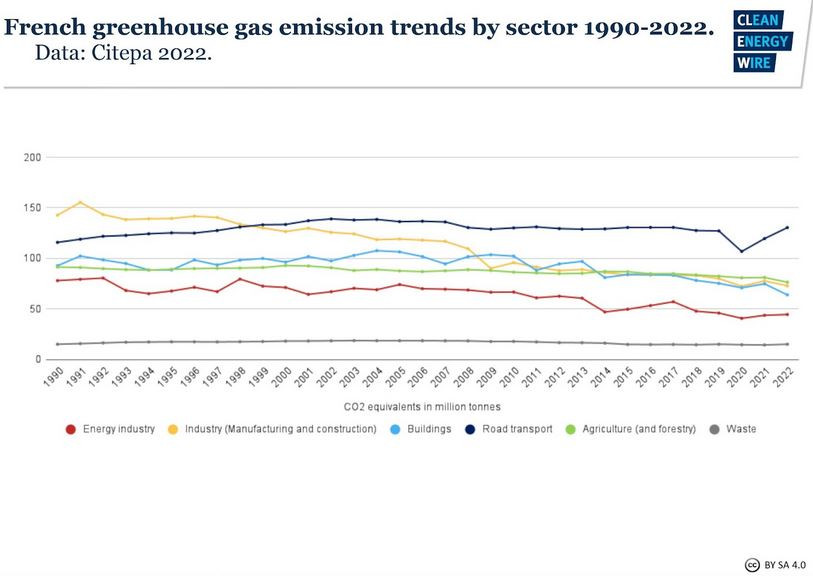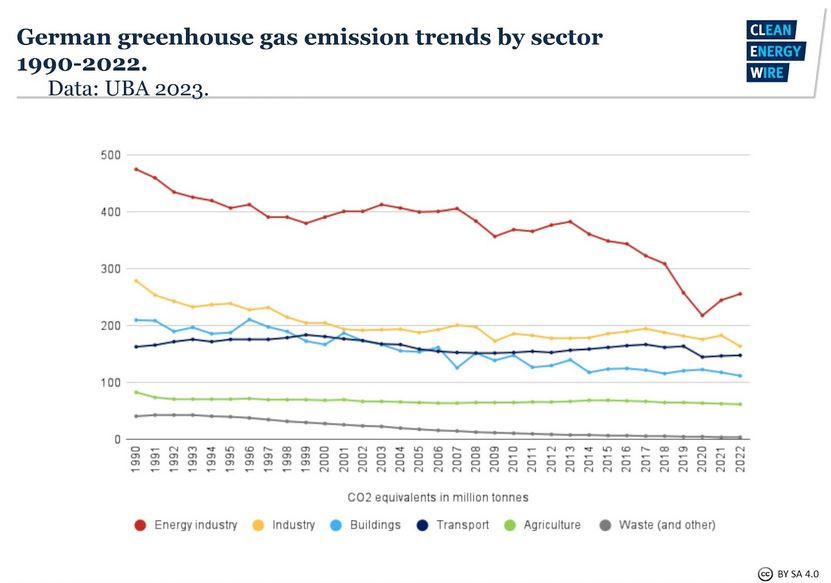How Germany’s and France’s climate policies and greenhouse gas emissions compare
*** Please note: this factsheet is part of CLEW’s first cross-border cooperation, exploring the Franco-German approaches to climate and energy and how these affect the vision of the EU’s energy future, which you can find here. Also read the main article French and German energy discrepancies hamper joint EU climate strategy, as well as the accompanying factsheet How energy systems and policies of Germany and France compare. ***
Germany and France are the two largest economies in the European Union and play a key role in the bloc’s goal to become greenhouse gas neutral. Both countries aim to achieve net zero emissions by about the middle of the century - France by 2050 and Germany by 2045. Whether or not these ambitious goals can be met will for the most part rely on their government’s policy decisions in various sectors, especially the most energy-intensive 0nes, and subsequently on their swift implementation. But with roughly 25 years left to radically change their energy systems, meeting those targets will depend on the coherence of European efforts that are taken in the near future.
Highlighting the two countries' structural similarities and discrepancies gives us a better understanding of where both of them stand as of 2023 and where they are headed given current trends. A caveat is that an entirely accurate comparison of available datasets is not always feasible between the two countries. This is due to the intrinsic complexities of counting emissions, investments and other developments in climate and energy policy, as well as the countries using different definitions, framings and accounting procedures to quantify their efforts.
Quick facts
(Sources: Worldbank, Insee, IMF, Destatis, EU Commission, EEA, EU Parliament, BDEW, RTE, Energy Renewable Capacity Statistics; figures for 2022 unless stated otherwise )
|
FRANCE |
GERMANY |
|
|
Area |
544,000 km2 |
358,000 km2 |
|
Population |
66 million |
83 million |
|
GDP estimate 2023 |
2.9 trillion dollars (44,000 dollars/capita) |
4.3 trillion dollars (51,000 dollars/capita) |
|
Industry share of GDP |
13.3% |
23.5% |
|
Greenhouse gas emissions 2021 |
302.33 megatonnes (4.5 tonnes/capita) |
665.88 megatonnes (8.0 tonnes/capita) |
|
Emissions reduction 1990-2021 |
-24% (ca. -124,420,000 kt CO2eq) |
-41% (ca. -522,843,000 kt CO2eq) |
|
Emissions reduction targets compared to 1990 levels |
-40% by 2030 (-50% proposed in 2023), net-zero by 2050 (only CO2) |
-65% by 2030, -88% by 2040, net-zero by 2045 |
|
Share of renewables in power production |
27 % |
44% |
|
Share of renewables in primary energy consumption |
14% |
17% |
|
Share of renewables in final gross energy consumption |
20,7% |
20,4% |
|
Installed renewable power capacity |
65 GW |
150 GW |
|
Installed nuclear capacity |
61 GW |
4 GW (decommissoned in April 2023) |
|
Installed coal capacity |
2 GW |
37 GW |
|
Installed gas capacity |
13 GW |
31 GW |
Nuclear gives France clear edge in energy sector emissions
As the two most populous country's in the EU, France and Germany are also the bloc's largest energy consumers. However, France boasts significantly lower greenhouse gas emissions than Germany, mostly due to low-carbon nuclear energy. In 2021, France’s fossil greenhouse gas (GHG) emissions stood at 302.33 megatonnes, roughly 45 percent of Germany's 665.88 megatonnes (EU Commission). Germany’s emissions were especially pushed by a high share of coal and its comparatively large industry.
While its higher total carbon footprint is partly due to its population being about one quarter larger than France's (83 million and 66 million, respectively), Germany also clearly leads in per capita emissions. With 8.0 tonnes of greenhouse gas equivalents per person in 2021, the Germans on average emitted almost twice as much as the French, who released 4.5 tonnes per capita.
Out of 27 EU member states in a 2020 ranking published by the Worldbank, Germany had the 6th-higest per capita emissions in 2020, whereas France came in below the EU-average on rank 21. France’s greenhouse gas emissions were reduced some 24 percent between 1990 and 2021, while Germany’s fell by roughly 41 percent during the same period (EEA).
France also ranked better than Germany in a 2020 comparison by the UN on emissions intensity per unit of GDP. The ranking found that Germany emits 0.14 kilograms of CO2 for every dollar of GDP, whereas the figure for France was only 0.09 kilograms - again among the lowest of all countries analysed.
While France has particularly low emissions in energy and industry, sectors traditionally covered by the EU Emissions Trading System (ETS), it scores worse in those that will only gradually be integrated into ETS regulation over the next years; including buildings, road transport or agriculture. The EU’s Effort Sharing Regulation stipulates emissions reduction targets specifically for these sectors, where systemic differences regarding nuclear power use are not decisive.
With a share of 30 percent, the transport sector was the largest emitter in France in 2021. In Germany, transport emissions stood at 20 percent, while the energy sector accounted for the largest share, with 34 percent of all emissions in 2022. By contrast, energy sector emissions only contributed 10 percent in France. Industry emissions in both countries accounted for comparable shares, with 22 percent in Germany and 19 percent in France, despite Germany having a much larger industrial share in economic output. France had a much greater share of agricultural emissions, in line with the sector's relatively larger role in the economy. With 19 percent in 2021, it was more than twice that of Germany’s 8 percent share in 2022.
Ambitious roadmaps for combating climate change
Both countries aim to achieve net-zero emissions roughly by the middle of the century and are bound by agreed EU emissions reduction targets. Paris had first set goals reduce emissions by 40 percent by 2030 (compared to 1990) through its National Low-Carbon Strategy, amended in 2020. In mid-2023, the government increased the target to 50 percent for the same period.
French multi-annual energy planning, adopted in 2020, determined that 40 percent of electricity production must be provided by renewable energy by 2030 and that nuclear power would reach 50 percent in the energy mix by 2035.
In comparison, Berlin's Climate Action Law, amended in 2021, provides annual reduction targets in order to reduce emissions by 65 percent by the end of the decade. Its net-zero goals are also more ambitious, as the country is aiming to achieve climate neutrality by 2045 (triggered by a seminal ruling of the country’s highest court), compared to 2050 for France (EU Parliament).
Details on how high unavoidable emissions will be for Germany and what can be done to compensate them are scheduled to be determined by 2032. The targets are set in line with the European Union’s (EU) reduction plans to cut greenhouse gas emissions by at least 55 percent by 2030.
Neighbours both too slow regarding emissions reduction progress

Irrespective of the difference in total greenhouse gas emissions, both countries struggle to bring relative emissions reduction to pace. In its June 2022 report, the French High Council for the Climate (HCC), an independent body tasked with issuing advice and recommendations to the government, said that while France's response to climate change was "progressing," it remained "insufficient" and that there is "still a major risk" for it to not meet its greenhouse gas reduction targets.
Indeed, France so far has not followed through on many climate promises. In May 2023, the Council of State urged the government to take "additional measures" to meet its CO₂ emissions target and ensure the "consistency" with its objectives in the rate of reduction. It is now asked to provide evidence of a straightening of its trajectory by mid-2024 at the very latest.
For 2022, provisional figures note a reduction of 2.5 percent of GHG compared to the year before. With 408 million fewer tonnes of CO2 equivalents, France narrowly reached the authorised limit of its national low-carbon strategy of 410 million tonnes.
As of 2023, Germany is also not on track to reach its 2030 climate target of 65 percent emissions reduction compared to 1990 levels. According to the government's projections from late 2021 (at the end of the last legislative period), the targets were expected to be exceeded by a total of 1,100 million tonnes of CO2 until 2030 without new measures.
The Federal Environment Agency’s (UBA) data shows that in 2022, Germany had reached a reduction of 40.4 percent to 746 million tonnes of CO2 equivalents. The country would have to triple the annual reduction from 2 percent in 2022 to 6 percent from 2023 onwards, UBA head Dirk Messner said.
With its Climate Action Law, Germany has also set the target to cut emissions by at least 88 percent by 2040. Emissions in the energy sector increased for the second year in a row (4.4% in 2022), as the country emerged from the pandemic and increasingly turned to coal and oil when Russia halted supplies of less CO2-intensive natural gas.
In Germany, it is clear for the energy sector how emissions have to be reduced: mainly by speeding up renewable energy expansion, environment agency UBA said. "However, in transport we don’t have a plan," it added. Transport CO2 emissions were about nine million tonnes above the target for 2022, as road traffic picked up again after the coronavirus pandemic. Emissions projections as of mid-2023 show the 2030 emissions gap can be reduced to about 200 million tonnes, of which transport is set to be responsible for 186 million tonnes. A policy proposal in the 2023 climate action package allows the sector to reduce emissions slower if the overall emissions budget is met.
Climate-related investments in France and Germany

France's climate investments reached 84 billion euros in 2021 (18 billion euros more than in 2020), according to I4CE. It underlines that progress has been made in most sectors, notably in low-carbon vehicles, renewable energy and energy-efficient building renovation. However, it warns that by 2030, the country would need to invest an additional 14 billion euros a year for a frugal transition, and up to 30 billion euros a year in a scenario where technical progress preserves lifestyles.
It also highlights the fact that investment in renewable energy totaled 9.5 billion euros in 2021. While investment in onshore wind power remains constant, it has risen sharply in solar power (with an increase in large-scale ground-mounted solar power plants), offshore wind power, biomethane injection and heating networks. In offshore wind power, the various projects launched over the past two years are ramping up and have mobilised more investment than in 2021. On the other hand, power generation from biomass and biogas cogeneration is set to reach a peak. Ambitious targets for district heating networks mean high levels of investment (in the region of 500 million euros a year) compared with 340 million euros in 2021.
In the nuclear sector, capital expenditure remained stable at 4.6 billion euros in 2021. Investments in the "Grand Carénage" maintenance programme for existing nuclear power plants increased slightly.
As far as state expenditures are concerned, climate-friendly spending in the Finance Bill (PLF) 2021 is estimated at 39.9 billion euros. Conversely, based on the assessment provided by the government, climate-unfriendly spending in the 2021 Finance Bill (PLF) is estimated at 9.6 billion euros.
In Germany, between 2023 and 2026, the government’s budget has earmarked some 177.5 billion euros for investment in climate action and transformation. In 2023, these amount to roughly 35.4 billion euros, the economy ministry (BMWK) said. Most of the funds up to 2026 are reserved for improving emissions reduction in the buildings sector (€56bln), funding guaranteed remuneration for renewables after the end of the country’s renewables surcharge (€35bln) - which might be less, depending on the market price for power - for industry decarbonisation and hydrogen investments (€20bln), and for relieving companies from high carbon price costs in the European Emissions Trading System (€12bln).
Germany needs to triple its planned state climate protection investments in order to reach its 2030 target to reduce greenhouse gas emissions, think tank Agora Energieweden estimated. The federal government will have to invest about 30 billion euros annually over the coming years – about twice as much as current plans foresee. Coupled with further investments at a local level, the figure will ultimately be three times higher than currently planned and reach 46 billion euros per year, the think tank found. In a comprehensive study for the need for total climate investments by 2045, Germany’s national energy agency dena gauged the bill at some five trillion euros in total, the majority of which would have to be channeled into the transport sector’s transformation. The dena analysis conducted by state-owned development bank KfW gauged that climate-related additional investments amounted to an average of 72 billion euros annually, or 1.9 trillion euros by 2045, both in private and public funds. Another 840 billion euros would need to go into the energy sector by the target year, the agency said. In a 2021 analysis, the national environment agency (UBA) found that Germany spent some 65.4 billion euros on environmentally harmful subsidies in 2018 alone, with the majority going into energy and transport.




